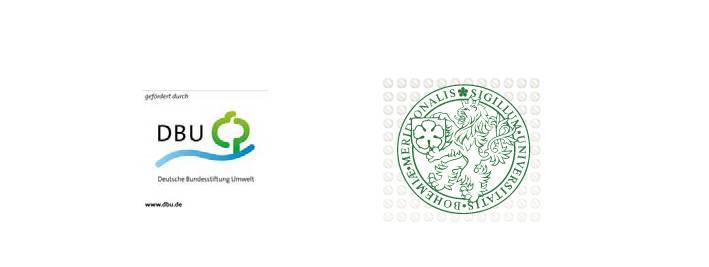Motivation
Motivation
Surface mining is one of the most important human-mediated disturbances in landscapes and their interlinked ecosystems. Sites affected by surface mineral extraction cover around one percent of the Earth’s land area. The direct impacts of surface mining are usually severe with large-scale removal of soil, vegetation, and animals.
During the last few decades, post-mining landscapes in Eastern Germany and the Czech Republic have been subject to scientific research on spontaneous or initiated vegetation recovery of heavily disturbed sites. Several studies have shown that spontaneous succession can lead to valuable high-diversity habitats with many rare species, particularly on heterogeneous and nutrient-deficient sites.
However, spontaneous succession needs time. Depending on local site conditions, plant colonization and the development of an extensive vegetation cover may take several decades. Thus, on sites endangered by wind or water erosion, or nearby settlements, an acceleration of vegetation development may be necessary and appropriate methods of assisted site recovery are indispensable.
Learning from nature can result in new ecological restoration strategies including the natural potentials of the sites into restoration schemes. The combination of spontaneous and assisted site recovery will result in the development of valuable habitats in post-mining landscapes.
In 2009, a joint research project was started between the Anhalt University of Applied Sciences in Bernburg and the University of South Bohemia in České Budějovice.
Project goals
Project goals
The aims of the project are to 1) formulate common mechanisms for colonization and succession occurring in the context of regeneration of European surface- mining areas and 2) develop general strategies for near-natural acceleration of vegetation development. Therefore, already existing permanent plot studies on spontaneous and assisted site recovery in the Central German lignite mining district and in the mining district of Bohemia (Czech Republic) have been continued and new demonstration trials on ecological restoration were conducted. Results and knowledge gained will be synthesized to produce concise guidelines for successful ecological restoration, which will be applicable for all Central European surface-mined land.
Example 1 - Slope restoration Roßbach (Germany)
Example 1 - Slope restoration Roßbach (Germany)
The mined site Roßbach is part of the Geiseltal mining district in Saxony-Anhalt. To initiate vegetation recovery, a trial was established in September 2000 on a bare slope. The substrate consists of dumped loess with a pH value of 7.5. We used three different restoration methods in block design with three repetitions: (1) Sowing of 15 herb and 6 grass species (2 g /m2, site-specific seed mixture of autochthonous species). After sowing, a seed-poor mulch layer was applied by hand to avoid erosion (c. 5 cm thickness). (2) Hay transfer from the nature conservation site ”Göttersitz”, which is about 20 km distant. We recorded 97 higher plant species on the donor site. The number of target species of dry and mesic grasslands amounts to 71. Seed-rich green hay was mown with cutter bar mowers, immediately transported to the mined site, and evenly distributed with a density of approximately 1 kg per m2 (c. 5 cm thickness). (3) Untreated control (succession). Each variant consists of a total area of 0.38 ha.
Results
The input of appropriate seeds via green hay and sowing clearly accelerated vegetation recovery. On treated plots, plant species already covered more than 40 % of the surface in the second year. From 2004 onwards, vegetation coverage at these sites was continuously high. Moreover, the mulch layer effectively controlled erosional processes, while erosion was severe on control plots. Both methods (hay transfer, sowing) led to the rapid establishment of species-rich, site-specific grasslands. The treatment with hay transfer was most successful. Here, we found between 30 and 40 target species in all years. Both methods are appropriate restoration tools when a fast vegetation development as well as erosion control is desired.
Example 2 - Slope restoration Profen (Germany)
Example 2 - Slope restoration Profen (Germany)
In mined areas, slopes often are re-vegetated by using low-cost seed mixtures containing only a few grass cultivars (e.g. Festuca spec.). In the Profen mining area (Zeitz-Hohenmölsener mining district, Saxony-Anhalt), we compared differences in vegetation development of a low-diversity seed mixture to a high-diversity mixture with seeds of regional origin. In December 2004, four different sowing variants were tested on an unvegetated slope with nutrient deficient raw soil: (1) low-diversity seed mixture with three grass cultivars, (2) low-diversity mixture with an additional mulch layer (c. 5 cm thickness), (3) high-diversity seed mixture with 40 herb and 11 grass species of regional origin (4) high-diversity mixture with an additional mulch layer.
Results
Sowing of a high-diversity seed mixture accelerated development to species-rich grassland communities. Over time, an increasing number of adjacent target grassland species also established on sites sown with a low-diversity seed mixture. However, differences in total coverage of the herb layer, and number and coverage of target species remained significant until 2010. Thus, using high-diversity seed mixtures of local provenance contribute to the enhancement of local biodiversity. The additional mulch layer facilitated the establishment of sown species and led to higher vegetation coverage in the first year, thereby preventing erosion. Even after six years, variants with mulch showed a signifycantly higher number of targets species.
Example 3 – „Klara’s Island” (Czech Republic)
Example 3 – „Klara’s Island” (Czech Republic)
In 2009, a workshop took place in České Budějovice. The main topic was restoration of psammophytic grasslands, which have become very rare and fragmented in this region. Thus, it is important to support the establishment of psammophytic grassland species on suitable new sites such as sand pits. We used raking as a method to harvest seeds and cryptogam material in two different donor sites. We raked 250 m2 and gathered almost 1000 litres of material. The experimental trial was implemented on an island within the active sand pit Suchdol nad Lužnicí of the mining company Českomoravský štěrk a.s. (Heidelberg Cement Group). We used a ratio of 1:1 for donor and receptor sites. Three variants (control, two different donor sites) were established using a complete block design, with four repetitions.
Outlook and Download Project Results
Outlook and Download Project Results
In Czech Republic and Germany, data collection will be continued on all experimental sites to determine the long-term success of the applied restoration methods. Project results were published in a booklet: Near-natural restoration vs. technical reclamation of mining sites in the Czech Republic.

Management: Prof. Dr. Sabine Tischew (HS Anhalt), Prof. Dr. Karel Prach (University of South Bohemia)
Researchers: Dr. Annett Baasch, Dr. Anita Kirmer (HS Anhalt), Dr. Klara Řehounková (University of South Bohemia)
Funded by:Deutsche Bundesstiftung Umwelt



